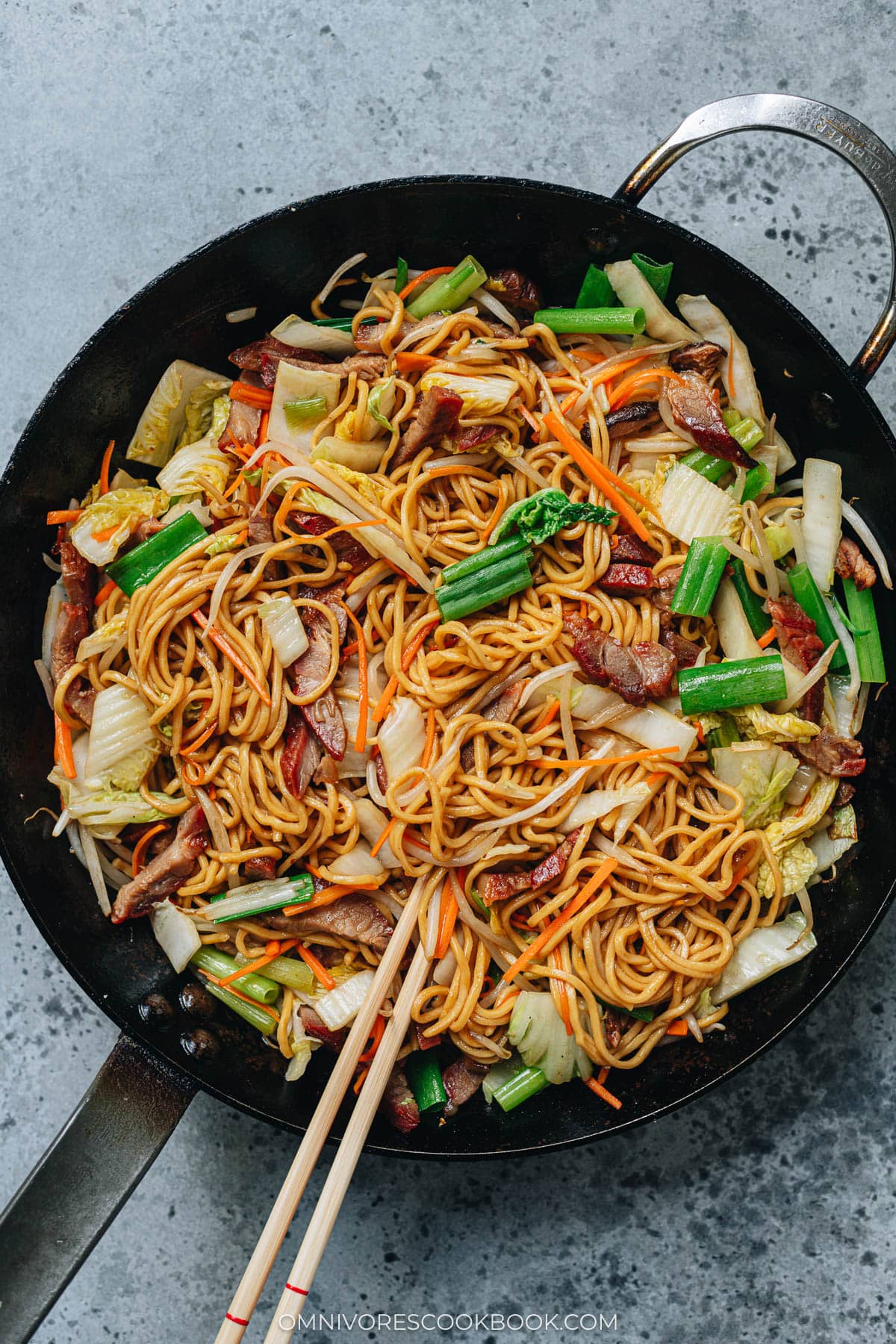
So you’ve successfully made Char Siu Pork for your guests, but there’s a chance that there are some leftover slices, still coated in that gorgeous glaze. What to do? There are so many options that you have for quick-to-cook yet stylish dinners for the rest of the week. For example, steamed char siu bao buns, baked BBQ pork buns, XO char siu fried rice, or even pork lo mein to create a one-pan dinner.
I always prefer a homemade lo mein over takeout from a Chinese restaurant. Because I like to load the noodles up with a lot of vegetables, creating a divinely filling and balanced meal that has a variety of great textures.
Ingredients
What type of noodles to use
The best noodles for pork lo mein are fresh lo mein noodles. They are thick egg noodles that are quite bouncy and chewy. You can find them at Chinese markets or large Asian markets such as H Mart. They are usually stored in the refrigerated or freezer section.
If the fresh type of lo mein is not available, dried lo mein is another good option and you can easily find them on Amazon or even at regular supermarkets.
Udon noodles are a good alternative if neither type of lo mein is available. Although they don’t contain eggs, udon noodles have a nice thick texture that is similar to that of lo mein noodles.
Mise en place
When you’re ready to cook, you should have everything prepared and chopped:
- Noodles: You might not be able to use a full pack of noodles and that’s OK. You don’t want to overcrowd the pan.
- Mixed sauce: This recipe uses a rich brown sauce with a chicken stock base. It includes oyster sauce, Shaoxing wine and light soy sauce for umami, and dark soy sauce to add a deep brown color to the noodles.
- Char siu: If you don’t have char siu, you can use pork tenderloin to cook this dish. See the footnote in my recipe for this adaptation.
- Carrots: I like to add carrots for their color.
- Napa cabbage: It’s one of my favorite veggies for lo mein, to create a crunchy yet tender texture that soaks up the sauce.
- Bean sprouts: For its crisp texture.
- Shiitake mushrooms: They add umami and a chewy texture to the noodles.
- Green onions: They add fragrance and natural sweetness to the dish.
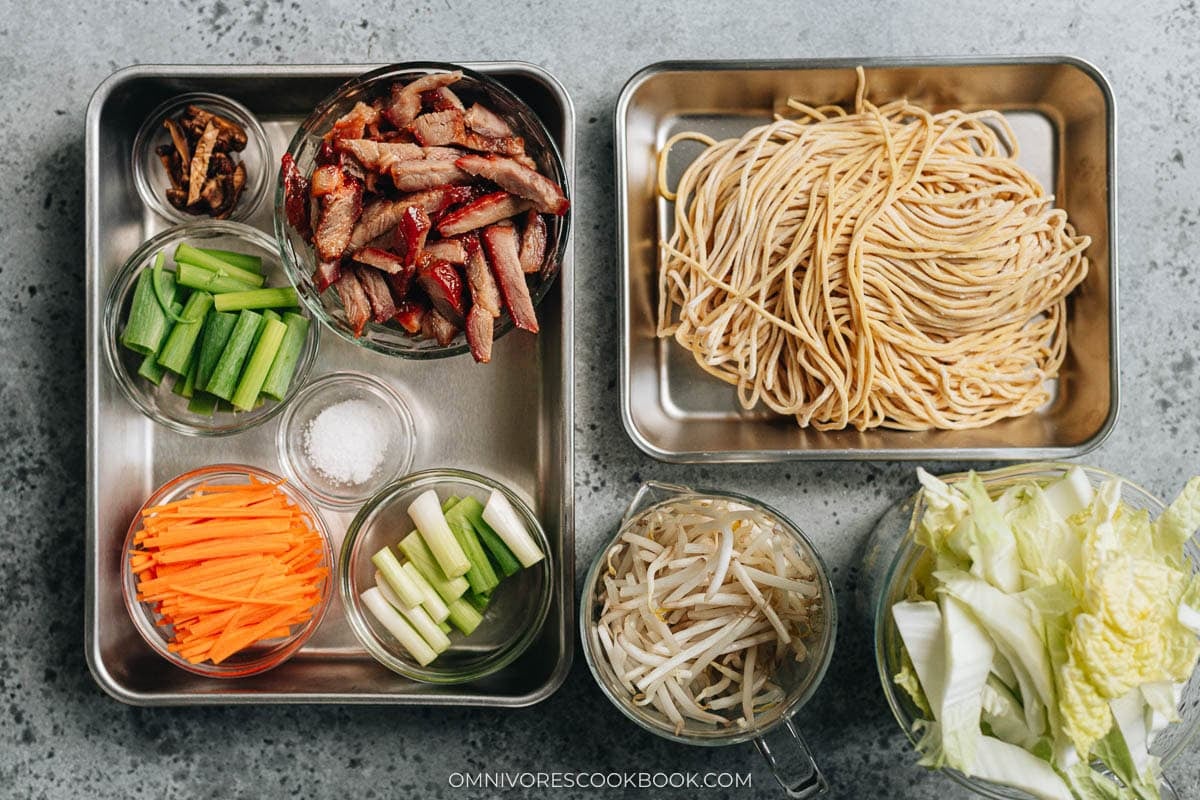
Other vegetable options
You can switch up the ingredients with other vegetables in your pantry. Here are some of my favorites:
- Bamboo shoots (julienned): they add crunchy texture and an earthy umami.
- Onion: It adds a crunchy texture and a sweet taste.
- Bell pepper or chili peppers: It adds a crisp texture, bright color, and spiciness if using chili pepper.
- Baby bok choy, chow sum, gai lan (stem sliced thinly), cabbage (thinly sliced): Great alternatives to napa cabbage to add texture and color.
How to cook
- Cook the noodles according to the package instructions minus one minute, so the noodles will be al dente.
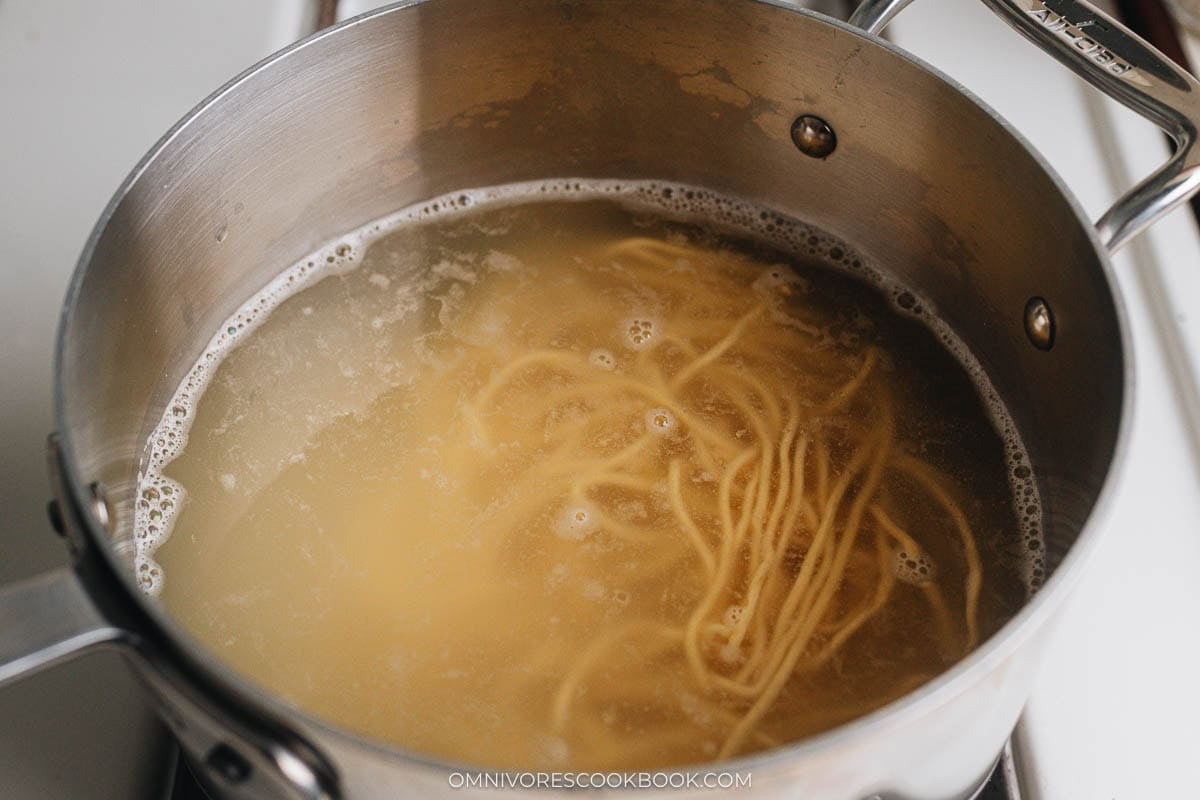
- Cook aromatics, shiitake mushrooms and carrots. It infuses fragrance to the oil, and allows the harder vegetable a longer cooking time.
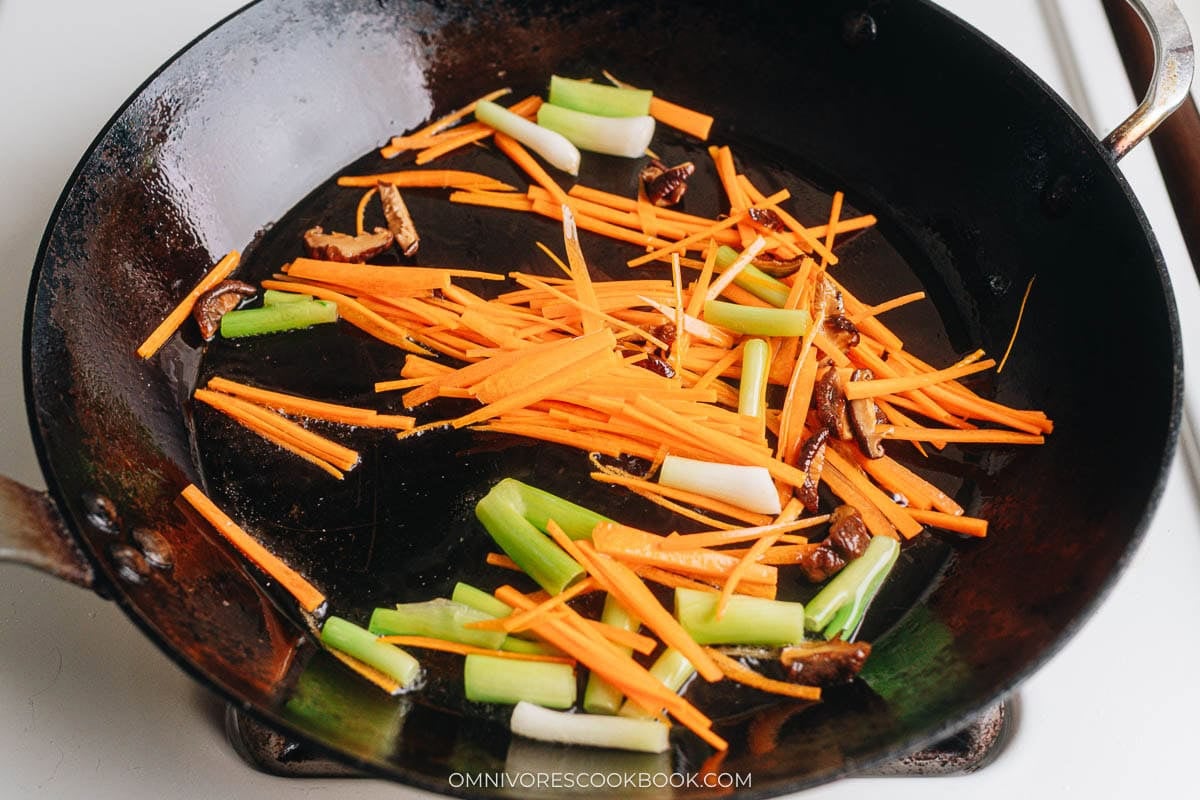
- Stir fry the napa cabbage until it just begins to soften, but is not very tender. The napa cabbage will keep cooking after you add the sauce. You don’t want to cook it too much at this point, as it could be soggy by the end of cooking.
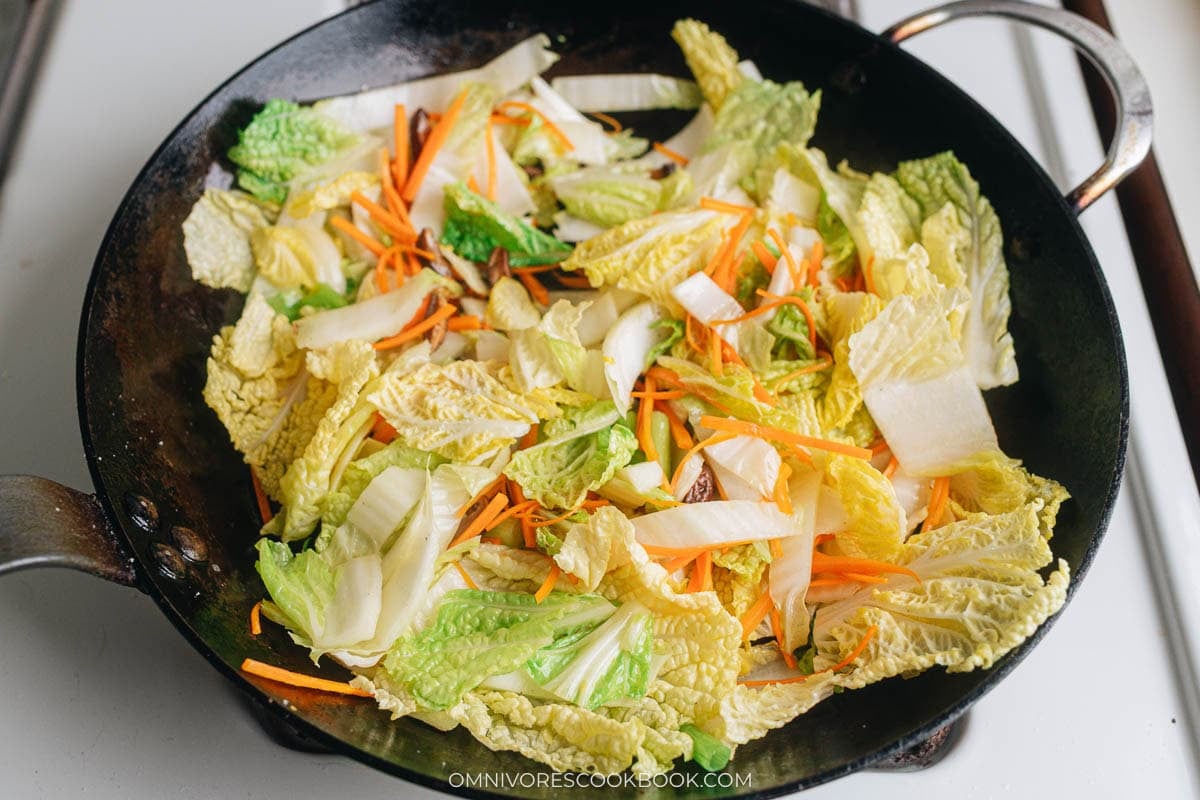
- Move the vegetables to a plate, briefly cook the char siu pork, then remove it, too. It’s important to transfer these ingredients to a plate and add them back later. So your pan won’t be overcrowded when cooking the noodles.
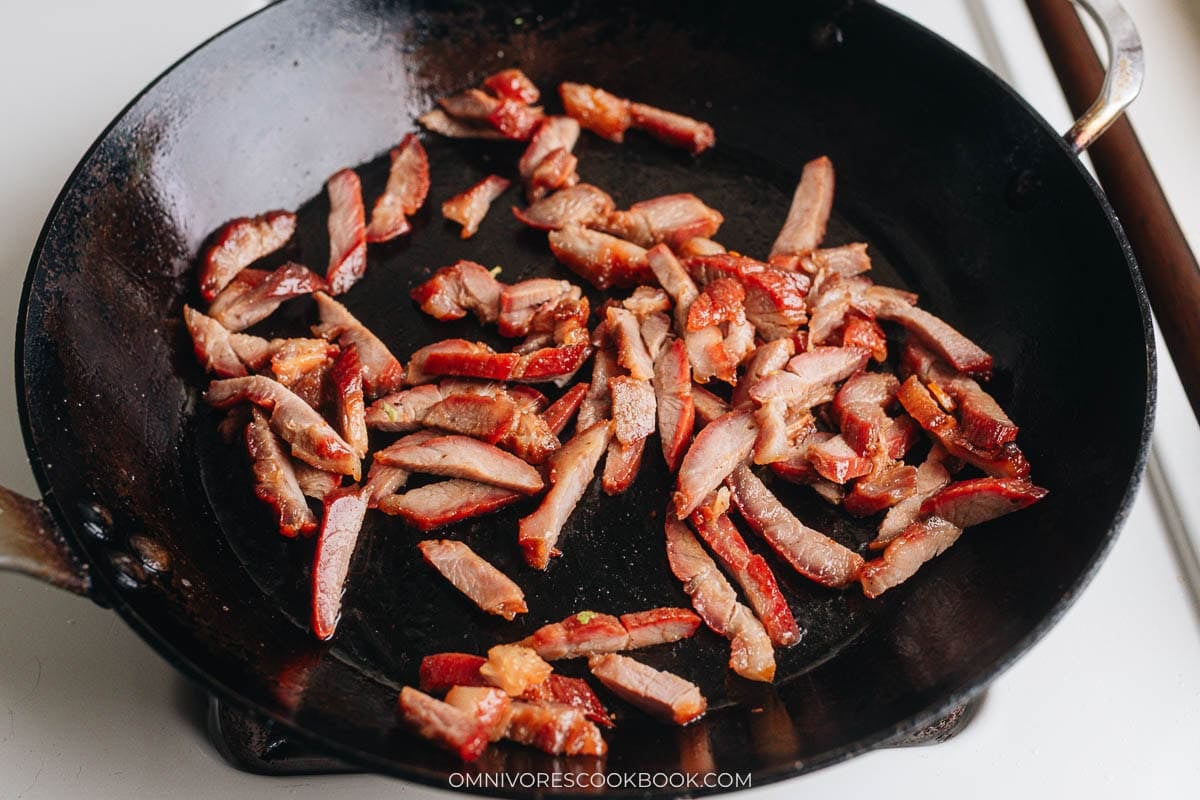
- Toss the noodles with oil and the sauce.
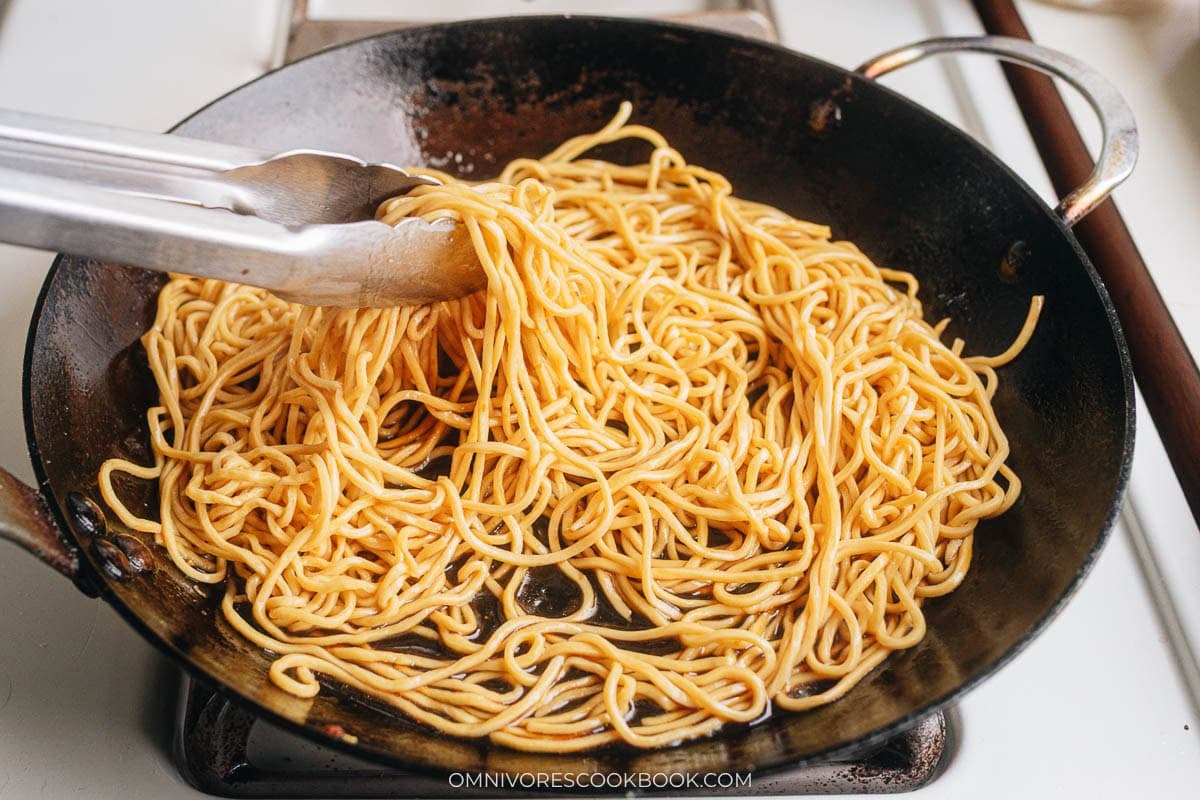
- Cook the bean sprouts, then transfer them to the plate with the other cooked vegetables, roast pork and scallion greens.
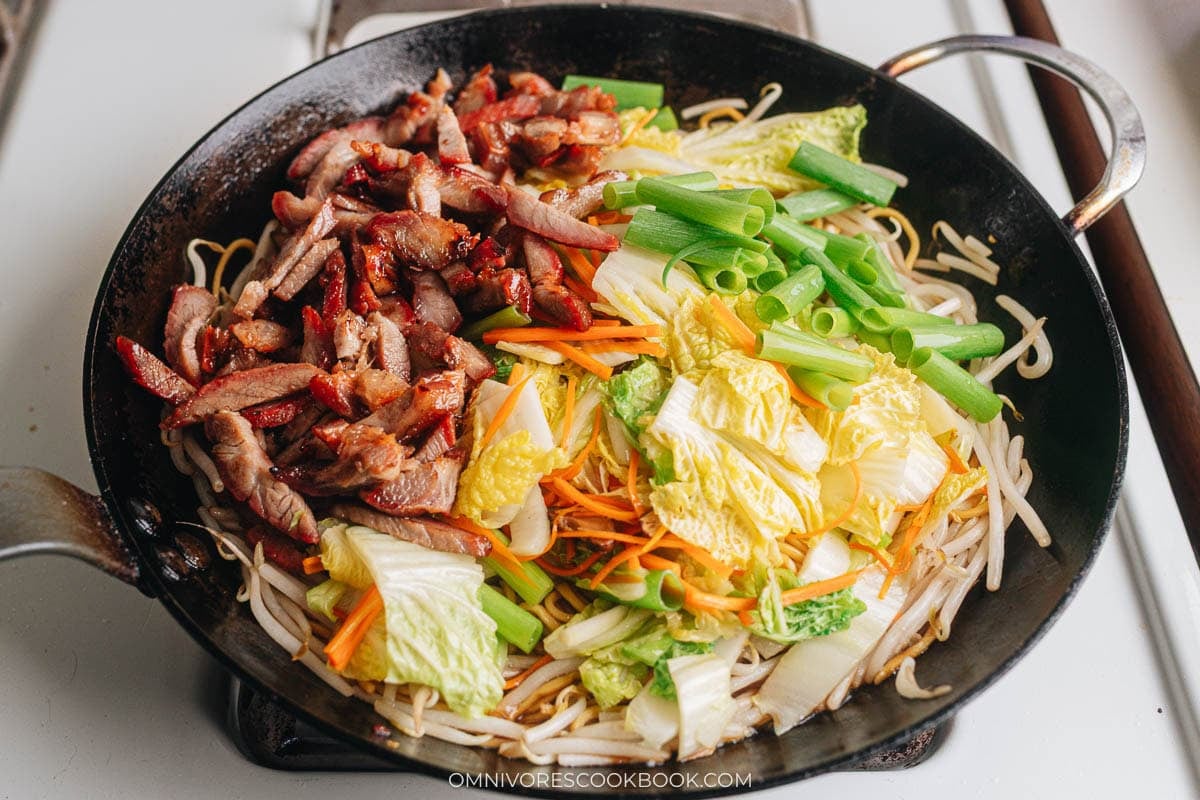
- Now toss everything together. This is where you want to taste the noodles and some veggies together. You can sprinkle some more salt to adjust the seasoning. If the vegetables are still a bit tough, cover the pan and steam everything together for 1 to 2 minutes. Steaming is a very fast way to cook the ingredients through and helps them further release flavor into the noodles. Because we slightly under-boiled the noodles earlier, the noodles can withstand a little more cooking and won’t become soggy.
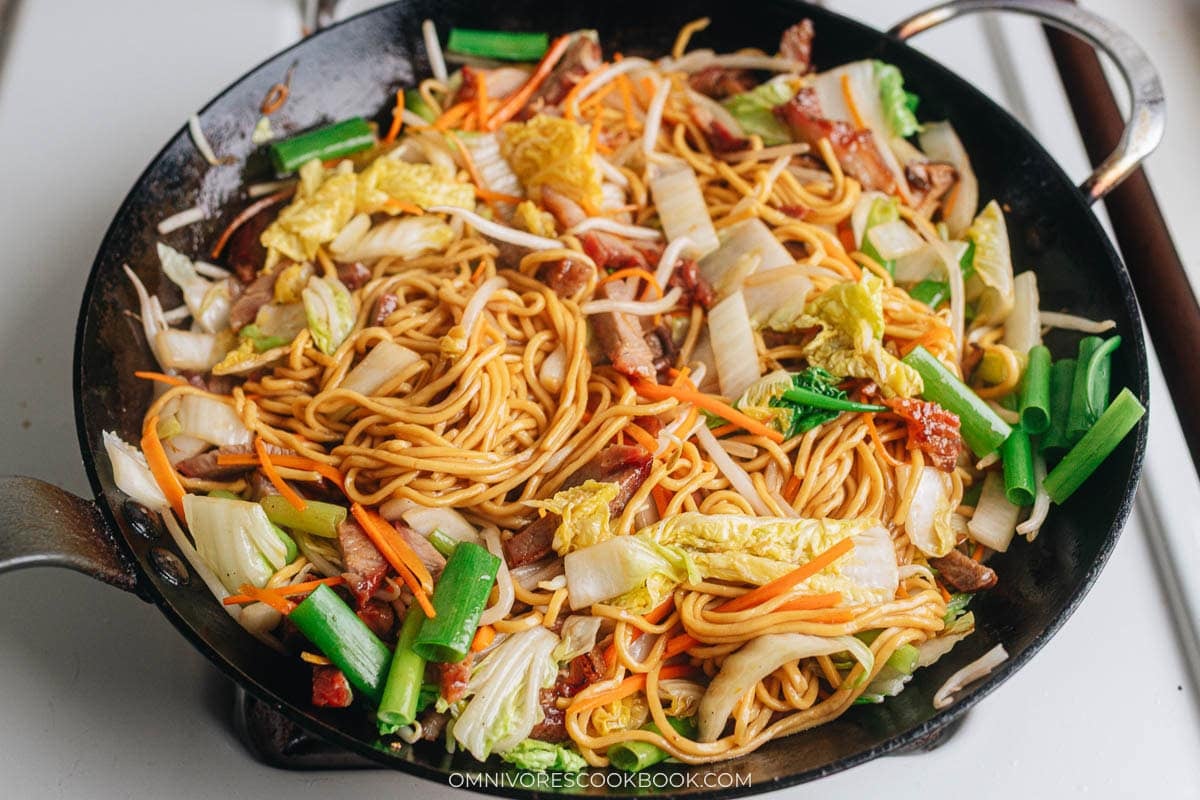
Now you’ll have extra loaded roast pork lo mein with springy noodles, tender-crisp vegetables, and a rich taste that’s full of fragrance.
Keys to success
- Don’t overcrowd: The recipe below is the maximum amount of food I would cook in a 12” skillet (or a 18” wok). Any more food will lead to the ingredients not searing properly.
- Cook the noodles just right: Boil until slightly underdone, then finish cooking them in the stir-fry to avoid mushy noodles.
- High heat is key: A hot wok or large skillet (which gives you more contact surface with the heat) gives the ingredients a proper sear.
- Use a generous amount of oil: The oil absorbs all the flavor from aromatics and the mushrooms, bringing the sauce and the ingredients together. It also gives the noodles a better texture.
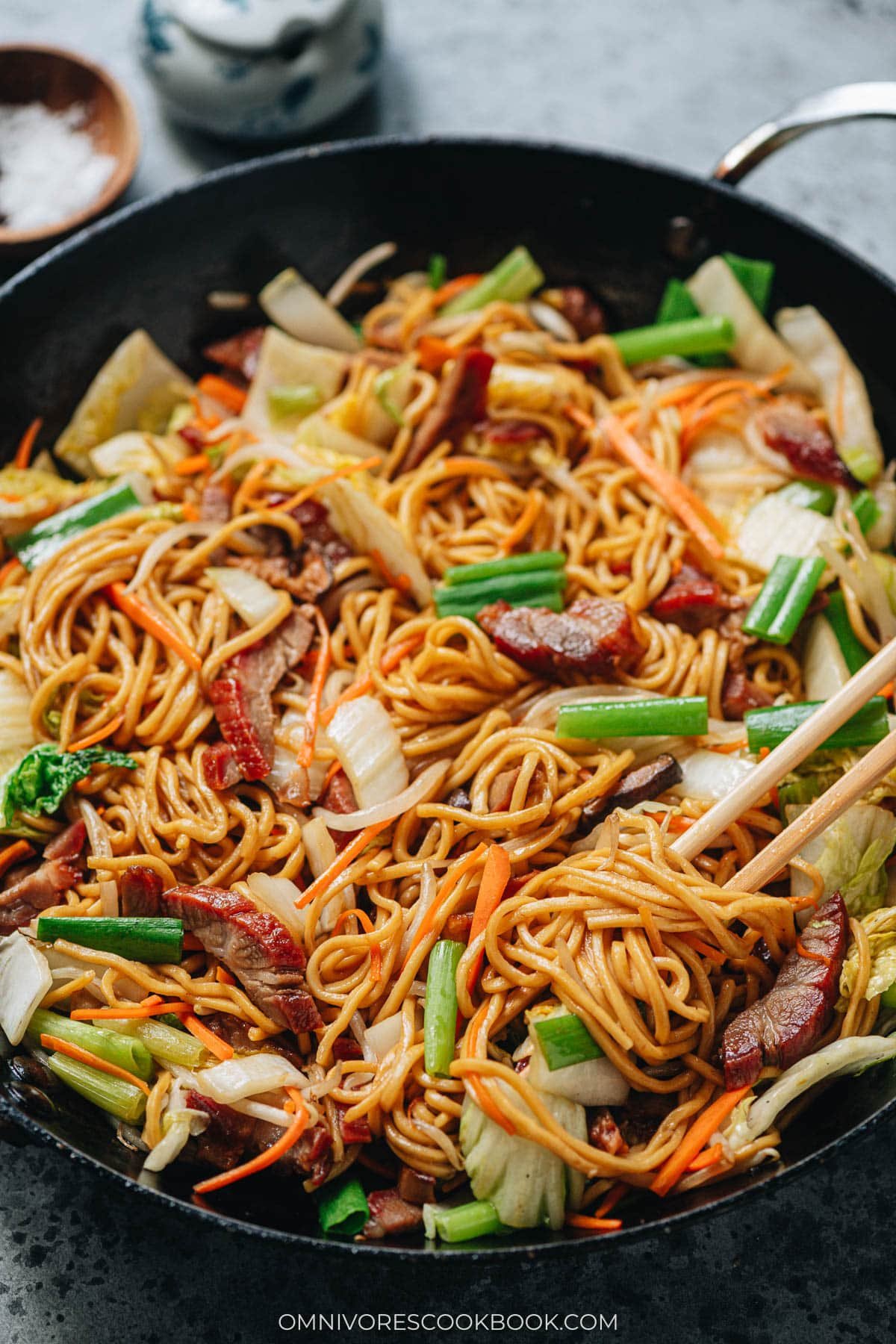
How to serve
- Serve roast pork lo mein as a main dish with a simple side of Chinese soup, like egg drop soup or hot and sour soup.
- Serve chili oil or pickled vegetables (such as pickled daikon, or pickled cucumber) on the side for extra zing.
- Make it part of a larger Chinese dinner spread with stir-fried greens and dumplings.
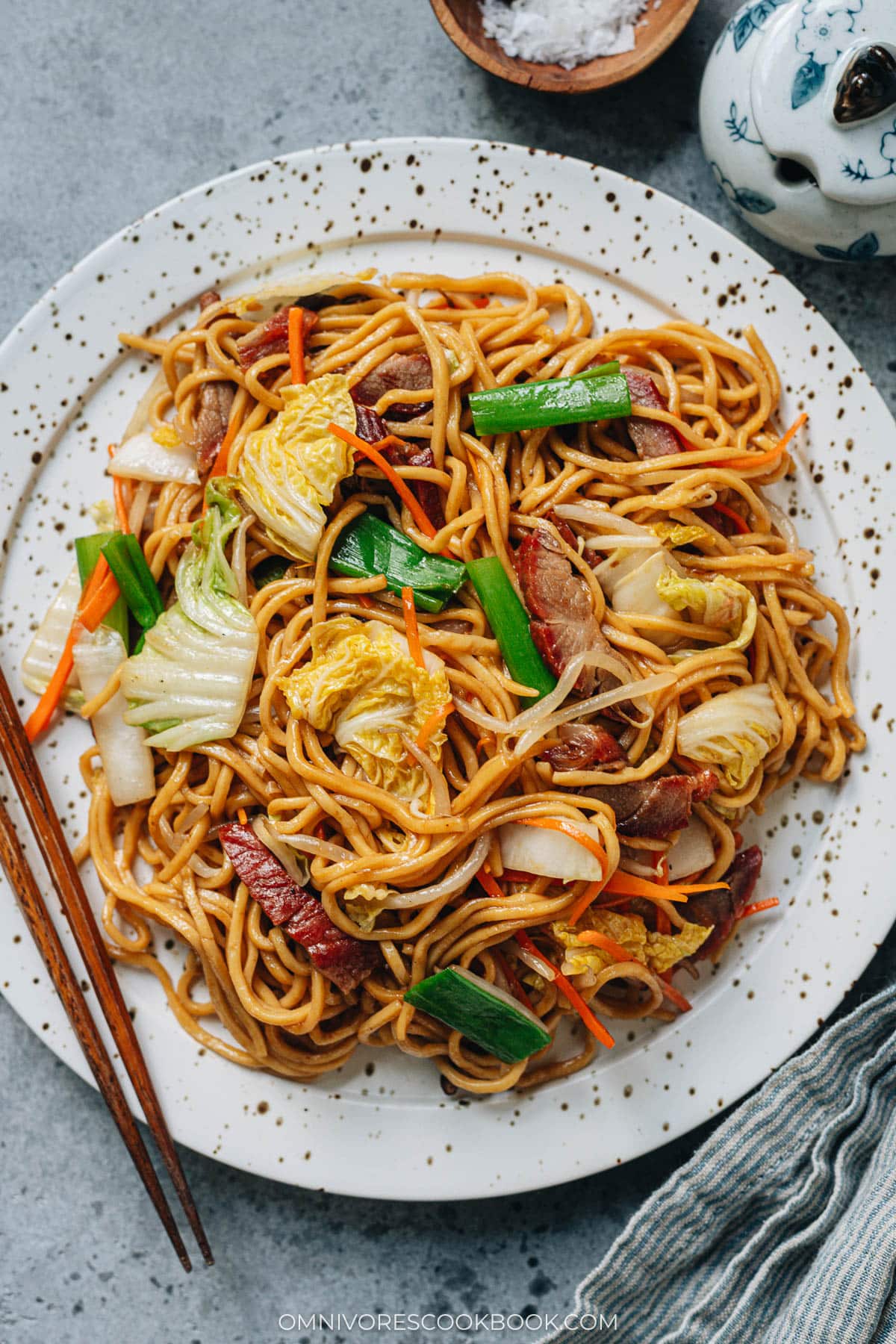
Frequently asked questions
Do I need to make char siu from scratch?
Not at all. Store-bought BBQ pork from a Chinese BBQ shop works perfectly and saves a lot of time. You can also use raw pork directly, to cook this chow mein for a delicious result.
Can I use other proteins instead of char siu?
Yes! Roast chicken, shrimp, beef, and tofu can be used instead.
How do I keep the noodles from sticking together?
After boiling, rinse the noodles briefly under cold water to rinse off the starch. Right before adding the noodles to the stir fry, if the noodles are stuck together again, rinse them with water, fluff them, and drain them again before adding them to the pan.
Other delicious noodle recipes
- Chinese Beef Chow Mein (牛肉炒面)
- Chicken Chow Mein (鸡肉炒面)
- Beef Chow Fun (干炒牛河)
- Chicken Mei Fun
- Authentic Chinese Noodle Recipes
- Singapore Noodles (星洲炒米粉, Singapore Mei Fun)
Chinese Cooking Made Easy
Are you new to this website? This free email series is a great place to start. I’ll walk you through a few of my most popular recipes and show you how and why they work. You’ll quickly start to cook better Chinese food in your own kitchen.
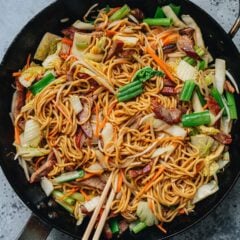
Roast Pork Lo Mein (叉烧捞面)
Ingredients
- 10 oz fresh lo mein noodles (or 8 oz / 225 g dried lo mein noodles)
Sauce
- 1/4 cup chicken stock
- 2 tablespoons oyster sauce
- 1 tablespoon Shaoxing wine
- 1 teaspoon light soy sauce
- 1 teaspoon dark soy sauce
- 2 teaspoons sugar
Stir Fry
- 3 tablespoons vegetable oil
- 8 oz char siu , sliced into thin strips (*Footnote 1)
- 1 (2 oz) carrot , cut into thin strips
- 4 dried shiitake mushrooms , rehydrated and sliced thinly
- 4 green onions , cut into 1 inch lengths, whites and greens separated
- 1/4 (1/2 lb) napa cabbage , slice white part 1/2” thick and greens 1” thick (yield 4 cups sliced)
- 1/2 teaspoon salt
- 2 cups bean sprouts
Instructions
- Boil the noodles according to the package instructions minus 1 minute, until al dente. Rinse with tap water to stop cooking, drain, and set aside. (*Footnote 2)
- Whisk all the sauce ingredients together in a medium-sized bowl.
- Heat 1 tablespoon of vegetable oil over high heat in a 12” pan (or a wok). Once hot, add the sliced shiitake mushrooms, carrot, and green onion whites, and saute for 2 minutes, until the vegetables are soft.
- Next, add the sliced napa cabbage and saute for another 1 to 2 minutes, until the cabbage starts to soften. Sprinkle with 1/2 teaspoon salt and toss to mix. Turn to low heat and transfer all the vegetables to a large plate.
- Add the char siu strips and turn to medium heat. Cook until the edges are lightly browned, then transfer it to the plate with the vegetables.
- Add the remaining 2 tablespoons of vegetable oil and the noodles. Toss the noodles to coat evenly with oil. Pour in the sauce and toss again to coat. Add the bean sprouts and toss again, 1 minute or so.
- Add back the vegetables and char siu, and the scallion greens. Toss to mix again. Taste the noodles and vegetables. Adjust seasoning by sprinkling a little more salt if needed. If the vegetables are still too tough, cover the pan and steam for another 1 to 2 minutes, until the vegetables are cooked to your preferred texture. Transfer to serving plates and serve as a main dish.
Notes
- You can use other types of cooked pork, like pulled pork, to cook this dish and get a great result too. If using uncooked pork, pork tenderloin is the best option. Thinly slice the pork against the grain into 1/8” (3 mm) pieces, marinate with 1/2 tablespoon Shaoxing wine, 1 teaspoon cornstarch, and 1/4 teaspoon salt. When cooking the pork, add 1/2 tablespoon oil first, and sear until just cooked through.
- If you’re using a wok to make this dish, you can boil the noodles in the wok. It’s usually faster this way because you will need less water to cook the noodles.
Nutrition

Did you make this recipe?
I’d love to hear how it turned out for you! Please take a moment to leave a 5-star rating ⭐️ and share your thoughts in the comments further down the page. It really helps others discover the recipe too.

Dat Wolf
Best noodles I’ve had in years…….. what a fabulous and simple recipe. Thanks!
BAS
Just made this and was it ever delicious! Easy to make and very addictive and authentic. Thank you Maggie.
Bill Zigrang
Maggie,
Time for a discussion (or link to same) re: Lo Mein vs. Chow Mein (noodles, technique, wet vs. dry, etc.). Difficult for a “big nose” like me to get his head around. Thanks.
Bill Zigrang (your proofreading nemesis)
Maggie Zhu
That’s a great idea! I w definitely should work on something like that.
Kevin Menard
I so love this recipe. It reminds me of the Chinese restaurant I used to dishwash for. The owner often made it for the help about midnight when we closed.
John Browne
That is really yummy.
I have been trying to make a good Chow Mein for a long time now.
This recipe takes the cake.
Thank you Maggie.
Kate
Had Char Sui left over and a google search led me to this recipe. Quick to prep, quick to cook, and sooooo tasty. Will definitely be making again
Errol
Thanks Maggie I had this dish last night.It was so nice.First time I have had Baby Bok Choy and loved the taste.With the sauces it was so nice.I let it steam with Baking Paper over pan which made the dish.Another Great Dish Of yours Maggie.Thank You
Adina
This is a great recipe. We enjoyed it and will make it again.
Angel
Best at home recipe! Thank you.
Melissa
Loved it!
Sportchic
My whole family loved this. Made the pork just for this dish but next time will make 2 for a meal plus this. Would be great with chicken or tofu.
Susan
Great! We loved it. But just note: green onions aren’t listed in the ingredient list. So I had to scramble at the end to get them ready. Thanks for the recipe!
Helen
Maggie – this is a delicious recipe! I didn’t have any cabbage on hand but I did have some wood ear mushrooms that added a nice depth of flavor. Thanks for sharing! 🙂
lyn
Tastes great! Make sure to not forget the sugar! I did the first time and it very salty. I also added mushrooms and bamboo shoots along with the cabbage.
LilyK
Cabbage?
Maggie Zhu
I updated the recipe in the past and the vegetable ingredient is a bit different now. It doesn’t contain cabbage, but you can easily replace the baby bok choy with cabbage if you wish.